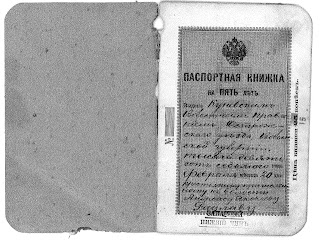In 19th
Century Russia, citizens were recorded for a variety of purposes. Certifying identity provided the government with
citizenship records providing data to tabulate taxes, to provide lists for
military conscription, to record social estate status, to record land
ownership, or to preserve hereditary information. Citizenship records were kept in two ways: 1)
metrical books recorded by the clergy, and 2) internal passports purchased by
the citizen from the local police.
Metrical Books (Metrika) first appeared under Peter the
Great as a tool for cataloging the population of the Russian Empire. Beginning in the early 1700s, the government
required that clergy keep the metrical books, starting with the Russian
Orthodox Christians. Gradually, the
requirement spread to other religions in the Empire including Protestant
Christian, Roman Catholic, Islam and Judaism.
However, Buddhists in the east and the recognized pagans in European
Russia, escaped registration in metrical books entirely. The books created the fundamental register of
identity in the Empire and served as the basis for civil status. Regardless of social station or religion,
citizens were required to report to clergy to have recorded births, marriages
and deaths. The records created the
official documentation needed to identify birthdates, social and civil rights
of an individual, and provided lists from which were drawn tax registers and
military draft notices.
The government
issued instructions to clergy that metrical books were serious records and
their maintenance was of utmost importance.
Yearly, parish clergy submitted their metrical records to local
government authorities. This inclusion
of the clergy into such vital record-keeping shows that the Empire’s government
was indeed moored to religious foundations.
However, suspicions arose from time to time that certain clergy were not
fastidious enough in their record keeping which the government may have
evaluated as sabotage or treason.
Catholics, Jews and Muslims were from time to time put down as being
poor record keepers. Obviously there
were many problems with this system; Lutherans wanted to keep their records in
German, and Tatar Muslims in their native languages, etc. What was to be done if a citizen converted to
a different religion or confessed to no religion at all? What if a new religion was formed? Metrical books lasted until the Tsarist
government was put down by the Bolsheviks and the process was never taken over
by civic authorities.
-“Between
Particularism and Universalism: Metrical Books and Civil Status in the Russian
Empire, 1800-1914”, Paul W. Werth, UNLV.
Passports (pasportnaya kniga): internal passports
had been in place in Russia since the early 18th Century as Peter
the Great instituted their use as a way to certify a person’s legal place of
residence. Internal passports,
identifying the bearer by occupation, residence, and estate, helped regulate
travel and prevented evasion of taxes and military conscription. Passports held by those belonging to lower
social orders were registered by the local administrative institutions or rural
societies and bound the holder to his residence and form of employment; the
passport illustrated that a person belonged in a particular place and to a
particular vocation. By the late 19th
Century, members of lower social orders received passports that were valid for
five years, after which time the bearer was required to renew the document. Each social estate had its own local
administrative body. All members of
lower social estates were held responsible for the collective burden of taxes
levied on their social estate. The
administrative body certified that an individual had paid his taxes and was
eligible for a passport. Yearly fees were
also paid on the passport as a sort of tax on free movement. Local administrative bodies could also place
limitations on a person’s free travel rights.
Literate passport holders, usually members of higher estates, signed
their document while the lower orders made their mark or recorded their
physical description. Members of higher
estates received passports which were less restrictive.
-Documenting
Individual Identity, Jane
Caplan and John Torpey ed, Princeton 2001.
Chapter 4, pp 67-80.
Andreas Ratzlaff’s
passport is an example of a pasportnaya
kniga.
